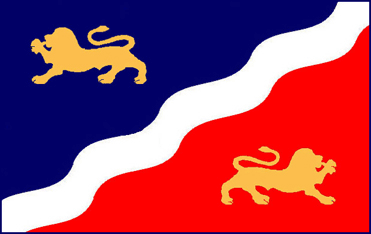
THIRTEEN YEARS OF EXPLOITATION OF LIMNOTHRISSA MIODON BLGR IN LAKE KIVU
THE UNITED REPUBLIC OF KIVU AND RWANDA
Originated by: Fisheries Department
Title: Papers presented at the Symposium on Biology, Stock Assessment and Exploitation ...
More details
ABSTRACT
Since the inception in November 1979, of the Fishery Project at Lake Kivu, fish catches steadily increased until 1988. After 1988, landings have shown a significant decline as a result of the decrease in abundance and the development of “outside-project” markets. However, the down ward trend was reversed by the end of 1989 despite the presence of “outside-project” markets.
In fact, landings have returned to high levels. This paper provides an account of
the fishery of Lake Kivu and reviews past and recent statistics and fishing trends of Limnothrissa miodon. The trends are reflected in various data sets which have been collected through acoustic surveys, fishing units sensus and catch assessment survey (KIVUSTAT). The data collected through the latter survey includes catch, effort and abundance. Future development needs for the Limnothrissa fishery in the lake are also emphasized.http://www.fao.org/DOCREP/005/V2648E/V2648E18.htm
1. INTRODUCTION
In the past, fishing activity on Limnothrissa miodon BLGR in Lake Kivu was unknown. Its exploitation began about fifteen years after the introduction of this small clupeid from Lake Tanganyika in 1959 (Collart, 1960). The fishery became important following the UNDP/FAO Fishery Development Project activities which started in 1979, on the Rwandese side of the Lake.
Since November 1979, fishing activities have been concentrated almost exclusively on Limnothrissa miodon, the only species representing an important fish stock among the 26 fish species in Lake Kivu (Snoeks et al., 1991).
The exploitation of this new resource is a result of a combined action by both private initiatives on the United Kivu side and an attempt, by Rwanda and The Netherlands Governments, the UNDP and FAO, to promote fishing in Lake Kivu.
Today, a total number of 2,868 fishermen are involved in the artisanal fishery activities and
beside this about 3,340 women make good profits out of the selling of the fish at the market places (Farhani, 1991).2. ENVIRONMENT
Lake Kivu is a mountain lake located between 1°84'38'' and 22°30'S and 28°50' and 29°23'E.
Its characteristics are a result of volcanic activity in the region. Its surface area is 2,370 km2 of which about 1000 km2 (42 %) belong to Rwanda and 58 % to the Kivu. A total of 250 islands representing 315 km2 are present. In United Kivu, Ijwi Island is the biggest and it is 200 km2. Due to its great depth and very steep shores, the littoral area of Lake Kivu having access to oxygenated waters represents only 12 % (Beadle, 1981). The average depth is 240 m and the maximum of 490 m, is found in the north of the basin.The climate is continental humid, characterised by a short dry season in December to January followed by the long rainy season from February to May, the long dry season from June to September and a short rainy season in October to November. The average rainfall is 1300 mm.
Surface water temperatures vary between 22° and 24° C. A thermocline is observed at 20–30 m. During the dry season (June-July), there is a partial movement of water in the first upper 70 m. Below this depth, exists a deoxygenated layer. Below 200m the presence of methane gas is noted. The total volume of this characteristic gas in Lake Kivu has been estimated to be 50 km3 (Degens et al., 1972). The pH of surface waters is 9.45. Below 100 m, the waters are acidic.
Fish fauna comprises 26 species and they are separated into four families (Snoeks et al., 1991) : CICHLIDAE (the group has 18 species and it is dominated by Haplochromis);
CLARIIDAE (with two species), CYPRINIDAE (with five species.) and the CLUPEIDAE (represented by Limnothrissa miodon). After Limnothrissa, the Haplochromis species represent the most important resource of the lake.3. THE LIMNOTHRISSA FISHERY
3.1 Fishing units and effort
Two types of fishing units are now involved in the exploitation of L. miodon. These are trimaran and purse seine units and they are operated on the entire lake.
The fishing zones in which artisanal fishing units operate are located around three main fishing centres in Rwanda. These centres are Gisenyi, Kibuye and Cyangugu. In the United Republic of Kivu waters, the most important fishing zones are located in the bays of Bukavu, Katana and Kalehe (Fig. 1).Fishing effort is expressed in terms of fishing nights per fishing unit per fishing campaign (i.e. the number of fishing days per lunar month).
The average monthly fishing effort is between 20 and 22 nights. The number of fishing nights is determinated by the lunar cycle. During the full moon period, the intensity of moonlight reduces the power of lamps to attract fishes, and fishing does not yield good results. Other factors such as meteorological conditions (rain, the roughness of waves) and the availability of spare parts and fuel for lamps, have much influence upon fishing effort, especially in the United Kivu waters.
Early in 1976, four catamarans imported from Lake Tanganyika were observed fishing L. miodon in Lake Kivu (Ruremesha, pers. comm.). As a result of the presence of the UNDP/FAO Project, the number of catamaran fishing units increased steadily in the Rwandese waters. On the Kivu side, most of the fishing units were imported from Uvira (Lake Tanganyika). Since 1980, all catamarans have been progressively transformed into trimarans and the nets have been enlarged from 180 to 400 m2.
Regular fishing unit surveys are done to follow the fishing effort evolution. Fig. 2 provides the results of the fishing units census arranged according to the nationality and types of boats.
As implied above, the number of fishing units has increased since the beginning of 1979 and in September/October 1987 there were 46 catamarans and 118 trimarans totalling to 164 fishing units on Lake Kivu (Hanek et al., 1988).
Marked changes in the number and types of fishing units have taken place during the last six years. After the transformation of catamarans into trimarans and taking into account the creation of new fishing units, the total effort increased to 227 units in April/May 1990 (Lamboeuf et al., 1989; Mutamba & Mulindabigwi, 1989; Mutamba & Mulindabigwi 1990a).
The total number of trimaran fishing units (artisanal) at present is 208 (Fig. 2).
3.2 Catch statistics
When the fishing of Limnothrissa began, it was not possible to obtain reliable estimates of total catch from the whole lake. But, from the commercial catches landed in the project centres, it was possible to have an idea on the probable evolution of the catches. During the last 13 years the annual total landings from Lake Kivu (in project centres) have varied between 0.7 and more than 3000 tonnes (Fig. 3).
From 1979 to 1984, catches from all fishing units were landed in project centres. During that period landings are therefore reliable. From 1985, landings that where obtained in project sites began to oscillate partly as a result of the demand of fish around the whole lake and the subsequent development of markets outside the project area. The catches are very irregular and vary from one year to another. The variability of catches depends also on meteorological Page 3 of 11 PAPERS PRESENTED AT THE SYMPOSIUM ON BIOLOGY, STOCK ASSESSM...
26/06/2007 http://www.fao.org/DOCREP/005/V2648E/V2648E18.htm
conditions, the number of active units per night, the competence of the crew, as well as on the fishing techniques and the condition of equipment.In order to obtain information on the real catches from the whole lake, a catch assessment survey called KIVUSTAT was established in January 1990. A total of 13 landing sites around the lake were selected using the information on outside project markets (Mutamba & Mulindabigwi, 1989).
A daily average catch per unit of effort is calculated on the basis of the catches of the sampled fishing units. Then a rate of activity of the fishing units is calculated and raised to the total number of units operating on the lake in order to obtain an estimate of total catches in the whole lake. Catches of the three purse seine units are added to this total.
The overall catches of L. miodon for the entire lake have been evaluated and the values obtained are at 2,660 tonnes in 1990 and 3,195 tonnes in 1991. Average catches of 221.7 and 266.3 tonnes per month were observed in 1990 and 1991 respectively. During the same years monthly catches varied from 177.2 in July to 352.1 tonnes in April (Fig. 4). Landings in project centres represented only 18 % in 1990 and 12 % in 1991 of the total catches in Lake Kivu (Lamboeuf, 1991a; Lamboeuf et al., 1992).
Catch data obtained on the basis of the size of the area in each of the two riparian countries, give a yield of 1,117 tonnes for Rwanda and 1,543 tonnes for Zaïre in 1990, and 1,343 for Rwanda and 1,853 tonnes for Zaïre in 1991.
3.3 Catch per unit of effort
Catch per unit of effort (CPUE) varies considerably from one fishing unit to another and does not show a regular seasonal pattern (Marshall, 1990). However a general downward trend with two maxima in March-April and June-July can be identified (Fig. 5).
On the basis of the observations made on the units surveyed within the framework KIVUSTAT, the catch per unit of effort oscillate between 39 and 51 kg/night. The monthly averages of CPUE were 45 kg/night and 51 kg/night in 1990 and 1991 respectively.
3.4 Resource evaluation
Acoustics surveys done from 1989 to 1991 (Lamboeuf, 1991b) have revealed that the abundance of L. miodon in terms of fish number varies between 1,080 millions (May 1990) and 1,997 millions (April 1989). This abundance oscillates around an average of 1,413 millions of fish. In terms of weight, these numbers represent an average of 4,315 tonnes with two maxima of 4,634 tonnes (April 1989) and 5,351 tonnes (November 1990) (Fig. 6). In terms of weight, the densities of fish tend to vary from 18.8 kg/ha to 22.6 kg/ha. If we consider densities in terms of fish number, the figures vary between 8,428 (April 1989) and 4,500 fishes/ha (May 1990).
Limnothrissa can be found everywhere in the lake, therefore it would not be possible to locate which regions are more productive than others. The concentration of fish in a given zone of the lake is influenced by the availability of food.
Most of the fish, that is 50 % by number and weight are located between 30 and 44 m deep.It has been noticed that L. miodon is found in deeper waters when the oxygenated layer is thicker due to mixing of the water.
Young fishes whose length is less than 60 mm are present throughout the lake (Lamboeuf, 1991b). This observation contradicts the finding of Spliethof & de lonch (1981) who indicated that the biggest fishes are exclusively located in the pelagic zone whereas the youngest are observed along the coastal (0 – 20 m depth) and littoral zones (20–60 m).
Page 4 of 11 PAPERS PRESENTED AT THE SYMPOSIUM ON BIOLOGY, STOCK ASSESSM...
26/06/2007 http://www.fao.org/DOCREP/005/V2648E/V2648E18.htm
According to Reusens (1987), Mutamba & Mulindabigwi (1990b) and Mannini (1990), fish of less than 54 mm in length can be observed in April and November, as a consequence of peaks of reproduction that take place from March to May and from September to February.
The presence of young L. miodon is a result of pulsions of reproduction that took place five or six months earlier (Lamboeuf, 1991a).The hydro acoustic surveys which were carried out from 1989 to 1991 gave an estimate of total biomass of around 4,315 tonnes but ranging from 3,445 to 5,351 tonnes of L. miodon (Lamboeuf, 1991b). The actual total catches, as indicated above, were 2,660 tonnes in 1990 and 3,195 tonnes in 1991. When these values are compared with those values of the on-the spot average abundance determined by the acoustic surveys and considering the fast growth rate (K = 1.28; L_ = 144 mm for 1989) and high mortality rate (Z = 9.62/year) of L.miodon (Mannini, 1990), the catches obtained are considered justified and the Lake Kivu Limnothrissa stock is not yet subject to high exploitation pressure.
3.5 The main fishery constraints
The fishing effort is influenced by meteorological conditions and by the lunar cycle. Under some unfavourable conditions fishing becomes so un-profitable that the fishermen stop all fishing activities over a period of about 7 days. Therefore fishing Limnothrissa in Lake Kivu is seasonal. The irregularity in catches compels fishermen to migrate to other sites, in search of better fishing grounds.
The irregular availability and the high cost of spare parts, fuel for lamps and fishing nets are the second type of constraints which are very acute for Kivian fishermen. These constraints have negative effects on the number of fishing expeditions and predispose some fishing units to give up fishing activities.Training and supervision of fishermen's economic activity can be improved. In Rwanda there are several unit cooperatives which were formed by 13 fishermen. One fishing team comprises 8 people and a team leader who is responsible for the boat. On the United Republic of Kivu side of the lake, fishermen are better organised. In that country there are fishermen and tradeswomen committees which collaborate closely, especially in order to determine fish prices. Despite this organisation, they have never been provided with opportunities for financial support such as credit.
4. FUTURE DEVELOPMENT NEEDS
Intensified exploitation of L. miodon is a response to high demand for the protein resource.
Therefore, it is necessary to sustain and develop this activity.4.1 Major problems with catch and effort data recording system
The UNDP/FAO Fishery Development Project on Lake Kivu has come to an end. One of the main objectives of that project was the rational exploitation of fishery resources. In the “after project”, the so called “unproductive activities” will be placed under the responsibility of government. Consequently, catch and effort data recording system is going to be interrupted because of lack of funds to maintain enumerators at work. In service and foreign training of national biologists in fishery management will face some problems.
With the end of the UNDP/FAO Fishery Development Project on Lake Kivu, the flow chart of catch and effort data recording system will lose some levels according to budgetary constraints. In order to maintain the present flow chart, there is absolute necessity to develop a cost effective method to gather fishing effort data which will minimize duration of enumerating boats without double counting and missing some fishing units.
Page 5 of 11 PAPERS PRESENTED AT THE SYMPOSIUM ON BIOLOGY, STOCK ASSESSM... 26/06/2007 http://www.fao.org/DOCREP/005/V2648E/V2648E18.htm
4.2 Cooperation and fishery policy
It is necessary to integrate catch and effort data recording system into the master plans of the Lake Kivu fishery management, or another research institution in each riparian country.
Soon after this, a management policy for the fishery would be established. In this way, tasks of controllers and regulation officers will need to be well defined, so that catch and effort data recording system should not be interfered with. From this catch and effort assessment surveys, fishing grounds of L. miodon should be mapped out.
It is necessary to establish and to activate collaboration and cooperation between Rwanda and United Kivu about fishery research management of the important Limnothrissa resource in order to maintain and standardize catch and effort data recording systems and acoustic surveys.4.3 Main research topics
Information on limnological aspects such as nutrient dynamics, lake productivity and energy transfer in Lake Kivu are outdated. Detailed qualitative and quantitative limnology studies are therefore needed.
In order to preserve the continuity of the resources of Lake Kivu, fishery services officials in Rwanda and United Kivu will be made aware of the necessity to control the exploitation of L. miodon stock. A research programme must be designed in order to obtain the various parameters necessary to the stock assessment.
The length frequency method should be adopted by the two governments and attempts should be made to acquire data for production models using methods that are less expensive and which take less time. Investigations are necessary to get information about breeding habits, nursery grounds and survival rate in the early life stages.From the few results of acoustic surveys already available today, it is now possible, as indicated above, to formulate some guidelines for rational exploitation and development of the Lake Kivu fishery.
5. CONCLUSION
Fishing of Limnothrissa in Lake Kivu has become an important economic activity which gives not only cheap protein resource, but also employment to almost 5,000 people in both riparian countries. The demand for this small clupeid is increasingly growing.
The few results we have analysed in this paper show that it is still possible to increase the fishing effort without danger. But, this activity must be sustained by consequent financial support in order to solve major constraints: i.e. fishermen's supervision, limnological information and supplementary fishery management data are still necessary. Collaboration and standardization of views between Rwanda and United Kivu at all levels or by those concerned with fishing activities on the lake are a great need. This will be possible only with international cooperation and funding.
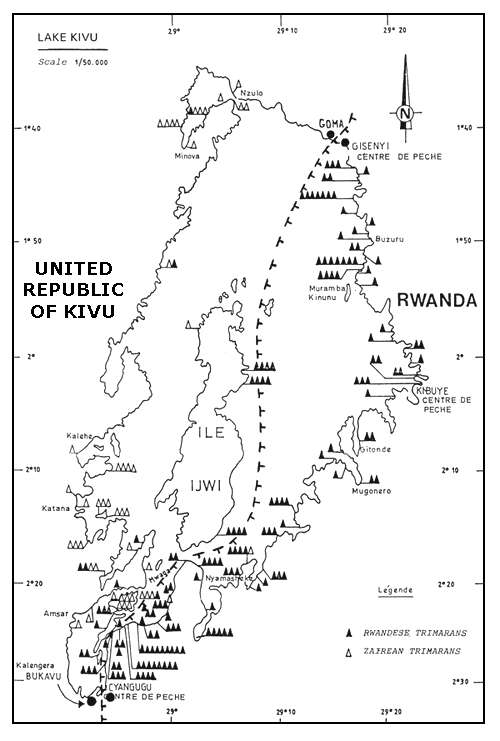
Fig. 1 Location of fishing zones and on-the-spot distribution of fishing units in Lake Kivu, 6 July, 1992
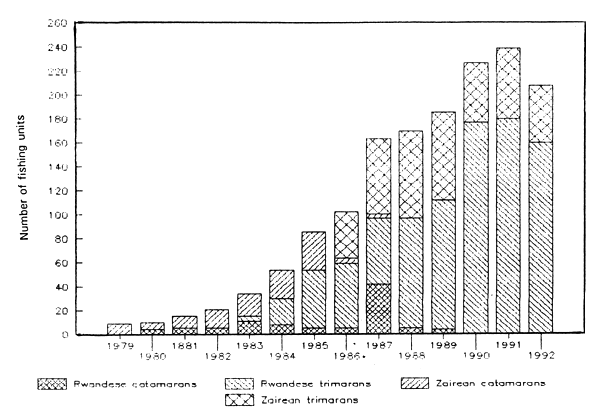
Fig. 2 Evolution of number of the Limnothrissa fishing units in the Zaire and Rwanda sectors of Lake Kivu, 1979–1992
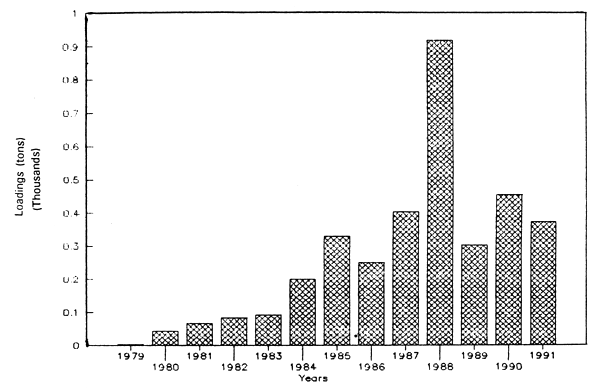
Fig. 3 Evolution of Limnothrissa catches landed at the centres of the UNDP/FAO Fishery Development Project on Lake Kivu, 1979–1991

Fig. 4 Total catches of Limnothrissa in Lake Kivu in 1990 and 1991. Catches are estimated by the KIVUSTAT system

Fig. 5 Monthly variation of the Limnothrissa CPUE in Lake Kivu; data have been averaged for 10 years, 1981–1990
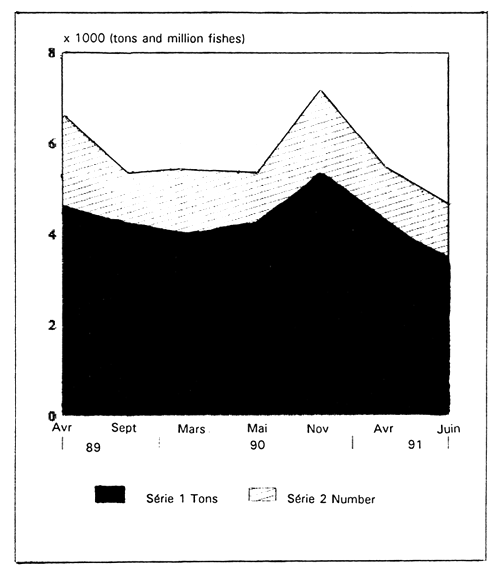
Fig. 6 Total biomass (number and total weight of fishes) in Lake Kivu as estimated by acoustic surveys from April 1989 to June 1991FFSA
Federation of the Free States of Africa
Contact
Secretary General
Mangovo NgoyoEmail: [email protected]
www.africafederation.net